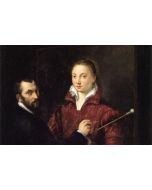Focus on: fashion in 16th century art

- Course Code: VB563
- Dates: 10/06/24 - 10/06/24
- Time: 10:30 - 16:30
- Taught: Mon, Daytime
- Duration: 1 session
- Location: Keeley Street
- Tutor: Julie Barlow
Course Code: VB563
Duration: 1 session
Please note: We offer a wide variety of financial support to make courses affordable. Just visit our online Help Centre for more information on a range of topics including fees, online learning and FAQs.
What is the course about?
The sixteenth century saw the development of portraiture in European art, and within it the emergence of a sophisticated visual language as a means to convey power and status beyond the literal likeness of a sitter. Costume and Fashion played a key role.
This art history course provides an opportunity to explore in depth the multiple ways in which costume was used, in portraiture. We will look at the work of Northern European artists including van Eyck, Holbein, Dürer, Gheeraerts, Mor, Eworth and the English painter William Larkin and discover how different Northern styles and fashions were from those in Renaissance Italy as depicted by artists including Bellini, Titian and Moroni. Fashions travelled and both French and Spanish courts led the way in the fashion stakes during the course of the century.
We will focus on key individual sitters to explore the important role played by costume and fashion in the creation of personal and public identity, both male and female. Queen Elizabeth I, with her extensive wardrobe of over 2000 dresses, was perhaps the monarch beyond all others who most employed portraiture for its symbolic potential. How did the developing global trade and the rise of a new merchant class affect fashion choices and styles, colours, shapes and raw materials? And whilst portraiture became increasingly dominant as subject matter, we will learn how costume and the depiction of textiles continued to play a key role in both religious and narrative painting of the period as a means to convey narrative. The Renaissance was the moment in art history when artists were concerned to bring their painted figures to life, to show their skill in depicting the human form in movement and drapery proved to be a significant tool in this quest.
The last portion of the course will be spent in the National Gallery looking at the 16th century fashion in the paintings on display.
What will we cover?
• How to place paintings within a broad social, political and economic context
• Key individual portrait painters
• Identifying the individual pieces of male and female costumes
• Developments in textile manufacture during the 16th century.
What will I achieve?
By the end of this course you should be able to...
• Discuss the significance of costume and fashion in sixteenth century art
• Give at least 3 examples of key costume designs as depicted by leading portrait painters
• Identify key features of costume design and describe their development through the 16th century.
What level is the course and do I need any particular skills?
This course is suitable for all levels.
You should be able to follow simple written and verbal instructions, demonstrations, hand-outs and health and safety information.
How will I be taught, and will there be any work outside the class?
In the classroom you will be taught by lecture and slide presentation. An offsite, guided visit will also be part of your learning. You will be invited to take part in group discussion. Handouts will be provided by your tutor to support your learning on the course and will be printed for you.
Please note: the offsite portion of this session take place during public access hours. Tutors are not able to control sound levels or behaviours of visitors outside of the course group. Unless you are a wheelchair user, and have confirmed access details with us (as levels of access can vary between galleries), you will need to be able to walk between exhibits and stand for some time while looking at them (you may bring your own portable stool if you have one, but we cannot guarantee access to any gallery stools). If you feel you may be impacted by these environmental variations, please inform the department on humanities@citylit.ac.uk before the course begins, to discuss reasonable accommodations we can make to assist your learning in the museum space.
Are there any other costs? Is there anything I need to bring?
You might wish to bring a notebook. You might wish to buy some of the books on any reading list given out in class.
When I've finished, what course can I do next?
Costume and fashion in art.
Julie Barlow has a degree in Art History/History from the University of Hull and an MPhil (Fine Arts) from the University of Birmingham. She has worked in a variety of roles at Leighton House, V&A and Tate Gallery before studying for a PGCE and moving into Museum Education. Julie has over twenty years of experience as a freelance lecturer at the National Portrait Gallery working on all areas of the Education Programme and also for the first ten years at the National Gallery and in the last decade at the Wallace Collection.
Please note: We reserve the right to change our tutors from those advertised. This happens rarely, but if it does, we are unable to refund fees due to this. Our tutors may have different teaching styles; however we guarantee a consistent quality of teaching in all our courses.
